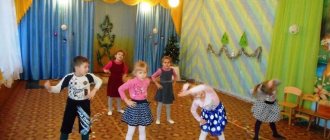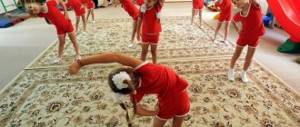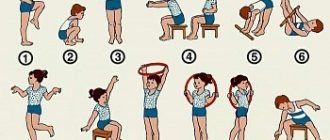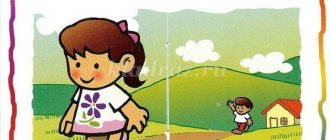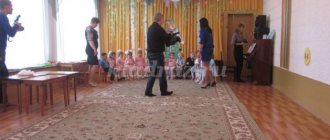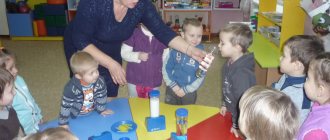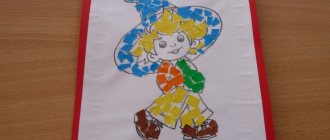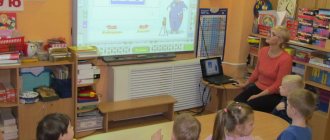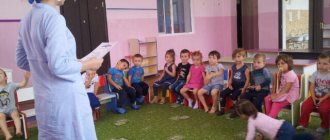The importance of morning exercises in the first junior group of preschool educational institutions
Morning exercises are an element of the daily routine designed to strengthen and maintain the health of children, raise their emotional tone and set them up for further activities.
Goals and objectives of morning exercises for children 1.5–3 years old
The educational goals of morning exercises are universal for preschoolers of any age and boil down to:
- formation, development and improvement of motor skills (for children 1.5–3 years old, this goal is the dominant one, since younger preschoolers are just learning to coordinate their movements, determine the direction of movements of their arms, legs, and torso);
- promoting health (forming correct posture, preventing flat feet, developing a beautiful gait);
- fostering a culture of health (children learn to take care of their health and learn the basics of physical education);
- stimulating interest in sports;
- developing the ability to coordinate one’s actions with the actions of other people;
- nurturing personal qualities (determination, independence, hard work).
Morning exercises create a positive emotional mood in children
To achieve the goals set in the first junior group of a preschool educational institution (DOU), the following tasks are aimed at:
- “awakening” the baby’s body from sleep (even taking into account the fact that preschoolers walk or drive some distance to kindergarten, many of them are in a sleepy state due to early rise);
- activation of the cardiovascular and respiratory systems of the body, organs and channels of perception of the surrounding world (mainly through running and jumping);
- strengthening the musculoskeletal system of children (through repetition of exercises to train the muscles of the shoulder girdle, torso, arms and legs);
- increasing the performance of children (gymnastics helps saturate tissues and organs with oxygen, which means children become more energetic);
- ensuring an organized start to the day (children perform movements together, and all subsequent routine moments in kindergarten also “by inertia” occur harmoniously);
- switching kids to joint activities (even if during the gathering of children in a group the children were playing different games and it was almost impossible to distract them, gymnastics will allow them to switch to a common activity);
- acquaintance with different sports (children not only learn the name, but also correlate the verbal description with the image, try on some sports activities, for example, skates).
Junior group. Early childhood, nursery. Children 1-4 years old
Summary of morning exercises with children of the younger group of early age. Summary of morning exercises with children of the younger group of early age. Theme: "Bunny"
.
Full name of the teacher: Shekhina Raisa Leonidovna. Goal: formation and improvement of motor skills with the help of morning exercises , preservation and strengthening of the child’s health.
Tasks:... Complexes of morning exercises for children 2–3 years old Complexes of morning exercises for children 2–3 years old for 2020-2021 September “TENDER CAT”
COMPLEX No. 1
(with elements of breathing
exercises ) INTRODUCTORY PART The teacher puts on a cat mask. Normal walking behind the cat (20 seconds. Normal running (20 seconds. Walking with a change of direction...
Techniques for conducting morning exercises in the first junior group
Like any other activity, morning exercise requires careful selection of how you interact with your work. Traditionally, 4 types of techniques are used.
Verbal techniques
The speech of an adult is of enormous importance for the development of a child. Especially if this concerns children 1.5–3 years old who are just starting to speak. In order for speech development to occur harmoniously, you need to talk to preschoolers, illustrating any action with words.
Explanation
Morning exercises must be explained. At the same time, the teacher tries to select short sentences with understandable words, speak slowly, and clearly pronounce all the words.
The teacher not only explains, but also shows all the actions
Puzzles
This verbal technique, which motivates children to work, requires from them not only a certain amount of knowledge, but also a vocabulary. Therefore, riddles begin to be played out in the second half of the year.
In my practice, I select riddles with rhyming agreements to make it easier for children to guess what is being said. For example, before performing a complex in the form of outdoor games, my children and I solve riddles in which the names of the exercises are encrypted:
- We returned at a late hour. Who greets us at the door? Who wags his tail with happiness and dances on his hind legs, licks his hands, licks his nose? This is our favorite... (Dog) - the game "Shaggy Dog".
- It can go and pour, There is water in the puddles. And not a hare, but a scythe, Sometimes it is torrential, In the fall it is a frequent visitor. Did you guess it? This is... (Rain) - the game "Rain".
- They scraped the bottom of the barrel, swept the barns. And through the forest, without roads, Rolled... (Kolobok) - the game “Kolobok is rolling.”
Poems
In my work, I also use this verbal technique to motivate students. Firstly, children enjoy listening to rhyming lines, and secondly, they quickly understand the essence of the topic. Thus, poems not only attract the attention of children, but also give them an idea of the tasks that will be in morning exercises. For example, if the kids and I are going to do the “Butterfly” story gymnastics, we start by listening to the poem of the same name:
- Amazing flower: Yellow, red patch! And along the edge there is lace. Oh! Head with a mustache! Here are the miracles: This is a beautiful butterfly! Summer beauty We all really like it!
Methodists also highlight sets of exercises that are performed to the accompaniment of poems (songs) that illustrate them - “gymnastics in verse.”
Table: examples of gymnastics in poetry (compiled based on open access materials)
| Title of the poem | Gymnastics move |
| "Matryoshka" | The nesting dolls gathered to play a little. They walked in circles and danced in a round dance. (Walking) Let's run after each other - (Running) These are funny girlfriends! They waved handkerchiefs, (Movements with their hands) They danced merrily, (Squats) They stomped their feet, (Movements according to the text) They clapped their hands. This is what kind of nesting dolls we are: (Tilts) We have red boots, Colorful handkerchiefs, (Blow on handkerchiefs) Satin ribbons. (Breathing exercise). |
| "Winter" | Children, line up in order for a fun exercise. To stretch our legs, we will walk along the path. And the path is not easy, It carries us along. (Walking) It’s frosty outside. To keep your nose from freezing, you need to stomp your feet (Stomp) and clap your palms. (Clap) Along the path, along the path We gallop on our right leg. And along the same path we gallop on our left leg. (They jump) We'll all go skiing, we'll climb the hill. Sticks will help us walk, The road will be easy for us. (They walk with long strides) And there are snowdrifts all around, the roads are covered with snow. Don’t get stuck in the field so that we raise our legs higher. (Hands on the belt, raise the knees) Let's run along the path, Let's run to the lawn. White flakes are flying, It has become colder. Only, winter-winter, you didn’t scare the guys. (Running) Snowflakes are falling from the sky, Like in a fairy-tale picture. We'll catch them with our hands and show them at home to mom. (Walking, clapping hands above your head) On the fluffy snow We started a game. You are a snowball and I am a snowball, stand in a circle, my friend. |
| "Palms" | Show me your palms and clap a little: Clap-clap-clap, Clap-clap-clap. Now look at me, (Make any movement) Repeat everything exactly. One-two-three, one-two-three. Now let’s show our legs and stomp a little. Top-top-top, Top-top-top. Show me your arms and legs, play with them a little. (Random movements of arms and legs) One-two-three, one-two-three. |
Video: morning exercises in the first junior group to a song
Short stories
I come up with such stories on the topic myself. From time to time, children need to be reminded of the importance of doing gymnastics, so one of the fairy tales could be like this: “Once upon a time there were two little men - Hilyachok and Fatty. One kept being capricious and didn’t want to eat anything, and the other did nothing but chew and never went far from home. One day they were sitting in the yard, and suddenly they saw a mischievous boy coming - Big Guy. They began to ask him why he was so happy and happy. And the big guy told them that he loves physical education, does morning exercises, eats cereals, vegetables and fruits. Then Hilyachok and Fatty began to take care of their health, doing physical exercise every morning and eating right. And within a month they became cheerful and joyful boys.”
When inventing fairy tales, you need to consider that:
- they should not be too long, otherwise children will be distracted from gymnastics;
- character names should be memorable;
- If possible, you need to select pictures to match the plot.
Fairy tales can be told from the perspective of a character who performs gymnastics
Visual techniques
Preschoolers perceive the world primarily through images. Therefore, visibility should accompany any type of activity of children. And morning exercises are no exception.
When working with my students I use:
- pictures depicting exercise characters - cats, dogs, bear cubs, etc.;
- illustrations of the order in which all elements of gymnastics are performed (for example, children running, jumping or the progress of work on the exercise “The bun is rolling”);
- demonstration (for the first younger group this is a demonstration of all the movements by the teacher or watching a video where gymnastics is performed by children’s peers).
Practical techniques
These types of work include types of creative activity:
- drawings;
- crafts;
- applications.
These techniques in the first junior group are reflective in nature: this is how children show their impressions of gymnastics. For example, after completing the “Let’s Rattle a Rattle” set of story-based gymnastics, the guys and I make an applique from blank rattles for the Tanyushka doll.
Performing applications, in addition to developing creative abilities, helps children remember the exercises
Gaming techniques
Play, as the main activity of preschoolers, provides a kind of framework for working on physical exercises. In morning exercises, outdoor games with theatrical elements are actively used.
Table: card index of outdoor games for morning exercises (compiled based on open access materials)
| Skill to be practiced | Name of the game | Tasks | Progress of the game |
| Run | “Sun and Rain” (“Rain”, “Sunny Bunnies”) |
| Children squat down behind the line designated by the teacher. The teacher says: “The sun is in the sky! You can go for a walk." Children are running around the playground. To the signal “Rain! Hurry home! run behind the marked line and squat down. The teacher says again: “Sunny! Go for a walk." The game repeats itself. |
| "Run to me" |
| Children stand on one side of the hall, so as not to disturb each other. The teacher stands on the opposite side. He says: “Run to me, everyone, everyone, run to me!” The children run to the teacher, who greets them warmly, spreading his arms wide to the sides, and pretends that he wants to hug all the children. After the children gather around the teacher, he goes to the other side of the playground and again says: “Run to me!” Before the start of the game, the teacher reminds that you can run only after the words “Run to me!”, You cannot push and interfere with each other. | |
| Orientation in space | "Shaggy Dog" |
| Children stand on one side of the playground. One child on the opposite side portrays a “dog”. The children quietly approach him, and the teacher at this time says:
Children approach the "dog". As soon as the teacher finishes reading the poem, the “dog” jumps up and “barks” loudly. The children run away, the “dog” tries to catch someone. When all the children hide, the “dog” returns to its place. |
| Development of balance | "Carousels" |
| The teacher invites the children to ride the carousel. Holds a hoop in his hands (being in the middle of the hoop) with multi-colored ribbons tied to it. Children take hold of the ribbons, the teacher moves with the hoop. Children walk and then run in a circle. The teacher says:
The children stop. |
| Strengthening the muscles of the trunk, spine, arch of the foot | "Kolobok is rolling" |
| Children pretend to be koloboks: they lie down on the carpet, straighten their legs and arms, and roll first in one direction, then in the other. At first, the adult helps the child, as if turning him over, saying: “Here comes Kolobok.” Rolling, rolling, can’t catch up with him.” Then the children roll themselves. |
| Formation of imitation skills | "Bubble" |
| Children and an adult stand in a circle. The teacher says:
Children, gradually moving back, expand the circle. When they hear the words “The bubble burst,” children lower their hands and pronounce the sound “sh-sh-sh.” |
| Agility development | "Frogs" |
| On one side of the hall there is a cord on the floor - this is a “swamp”. The “frog” children stand on the other side of the hall in one line on the starting line. The teacher says: “Here are the frogs jumping along the path with their legs outstretched, qua-kwa, kwa-kwa-kwa, jumping with their legs outstretched.” Children perform jumps on two legs in accordance with the rhythm of the poem, moving forward (about 16 jumps) to the “swamp”, and jump over the cord, saying: “Plop!” After a pause, the game exercise is repeated. |
| Formation of climbing skill | "Monkeys" | Exercise children in climbing a gymnastic wall. | The teacher invites the children, one or two at a time, to approach the gymnastics wall, stand facing it and climb 3-4 slats. These are monkeys. The rest of the children sit or stand and watch the monkeys pick fruit from the trees. Then other monkeys climb up the trees. |
| Development of attention | "Checkbox" | Teach children to stand in a circle and perform actions while singing along to a song | Children stand in a circle, in the middle of the circle there is a flag. The kids walk in a circle and say the text. The child comes out according to the text, picks up the flag, waves it and puts it back. Then the game continues.
|
This is interesting. Some morning complexes also include 1-2 exercises of finger games and/or breathing exercises.
Summary of morning exercises in the second junior group “Good Forest”
Yulia Kuznetsova
Summary of morning exercises in the second junior group “Good Forest”
Summary of morning exercises in the second junior group Topic : “ Good forest ”
Author : Yulia Kuznetsova
Goal: to promote the health of children and awaken the body for normal functioning.
Software tasks:
1. Educational:
— exercise children in walking and running, strengthen motor skills;
-promote the formation of natural types of movements (walking, running)
.
2.Developing:
— develop physical qualities and abilities;
-develop basic movements in exercises and independent motor activities.
3. Educational:
- give children an emotional charge for the coming day, help children relieve negative emotions.
Introductory part:
1.Walking: Good forest , old forest! Full of fabulous wonders! We're going for a walk now. And we invite you with us! Our feet walk along the level path, like this, like this, our feet walk. We follow each other, the forest and the green meadow.
2. Running, walking on toes: The bridge swayed to the sides. And under him the stream laughed, we’ll walk on tiptoes, we’ll get to the other bank. The motley wings flicker. Butterflies fly in the field. One, two, three, four - they flew and circled.
Educator: Children, we came to a beautiful clearing in the forest, and here in the clearing a bear lives. Guys, now you and I will turn into bear cubs. One, two, three, we circled. We turned into bear cubs. Now the cubs will do their exercises.
Main part: outdoor switchgear (without items)
1. Pull-up: In the morning, Little Bear woke up, Little Bear stretched towards the sun. Like this, like this, Mishka reached out to the sun. How great, what great fellows you cubs are.
2. Turns: The cubs lived in the thicket. They twisted their heads, like this, like this, they twisted their heads. How cool and correct you are doing the exercise, well done my cubs.
3. Bends: The cubs were looking for honey. Together they rocked the tree, like this, like this, together they rocked the tree. Like the bear cubs rocked the tree, like that, my guys, how smart you are.
4. Squats: Waddled around. And they drank water from the river, like this, like this, and they drank water from the river. Children, how did the cubs drink water, like that, well done, my cubs.
5.Jumping: Bears have fun playing. The bears want to play. One, two, one, two, the game is over. Guys, how the little bear cubs are having fun, like this, like this, well done my little bear cubs.
Educator: Stop! Charging has ended. Inhale and exhale for order. Goodbye, good forest ! Full of fairy tales and miracles! One, two, three - we circled. And they turned into kids.
Conducting morning exercises in the first junior group of kindergarten
When compiling a set of morning exercises, the teacher is guided, first of all, by ensuring that children have the opportunity to develop comprehensively, that is, different types of movements are selected. In addition, all the characters' lines, if any are implied by a specific type of gymnastics, are illustrated with movements.
It is advisable to include a variety of exercises in one gymnastics complex.
Table: card index of morning exercise complexes in the first junior group
| Name of the complex | Progress of the exercise | Accompanying words |
| "Watch" |
| “Show me how the clock goes. Tick-tock, tick-tock." |
| “The clock is ringing - bom-bom-bom.” | |
| “The watch is broken, we need to fix it with a special hammer.” | |
| Repeat the first exercise. | “So our watch started working again - tick-tock, tick-tock.” | |
| “Now we need to hang the clock higher on the wall.” | |
| “Now let’s show how quickly time flies.” | |
| "Turnip" | They go one after another. | “One grandfather and his wife and grandmother had a vegetable garden.” |
| They move on the outside of the foot. | “Once my grandfather went to plant turnips.” | |
| They jump forward, raising their arms. | “The weather is just fine, sunny, the birds are singing.” | |
| They walk on their toes, swinging their arms. | “Suddenly it started to rain.” | |
| They run with their hands clasped above their heads in a “house”. | “Grandfather ran home.” | |
| “Grandfather was going to plant a turnip, but he couldn’t find a shovel.” | |
| “The turnip became big, simply huge. Grandfather wanted to get it out of the ground, but he couldn’t.” | |
| “The grandfather began to call for helpers: grandmother, granddaughter, dog Zhuchka, cat Murka and, finally, mouse.” | |
| “So we pulled out a turnip!” | |
| “They all went home, ate, and then the helpers ran to their homes.” | |
| "Let's rattle the rattle" |
| "Let's rattle some rattles." |
| “Now let’s get the rattles.” | |
| Calm walking. | ||
Practicing a set of morning exercises is organized in 3 stages.
Table: timing of stages of morning exercises
| Stage | Goals | Types of exercises | Time |
| Introductory |
|
| 1–2 minutes |
| Basic |
|
| 2–3 minutes |
| Final | Restoring blood pressure and pulse. |
| 0.5–1 minute |
This is interesting. One complex can use 2-3 types of exercises from each stage.
When allocating time for each stage, you need to make allowances for the pace at which children perform the exercises.
Table: example of a summary of morning exercises in the first junior group (fragment)
| Author | Aleshina M., teacher of MBDOU D/s No. 42 “Solnyshko”, Zavolzhye, Nizhny Novgorod region. |
| Introductory stage | The teacher brings a bear cub into the group. Reads a quatrain, addressing the children:
The little bear invites the children to play with him.
|
| Main part | <… “Big bear, small bear cub.” Starting position (IP): Standing, arms down along the body. V.: We understand the hands, we will show how big Mishka is. That's what it is! We give up. This is Mishka's little teddy bear. We do it 3 times. "The bear is dancing." I. p.: Standing, arms down along the body. V.: Let’s show how Mishka dances. He leaned one way and the other, that’s how cheerful Mishka is. Do it 3 times...> |
| The final stage | <… The little bear invites the guys to walk in a circle:
Mishka praises the children:
|
| Quote from: https://www.maam.ru/detskijsad/provedenie-utrenei-gimnastiki-v-pervoi-mladshei-grupe-gimnastika-s-mishkoi.html | |
Video: morning exercises in the first junior group with a doll character
Summary of morning exercises for children of the younger group “Fun exercises”
Plan-summary of morning exercises for children of the younger group
“Fun exercises”.
Goal: to promote the health of children and awaken the body for normal functioning.
Tasks:
1. Form motor skills (walking, running, jumping).
2. Develop physical qualities and abilities, basic movements in exercises and physical activity.
3. Strengthen the health of children, develop all body systems.
4. To instill in children the need for daily physical exercise.
5. Give children an emotional charge for the coming day, help children relieve negative emotions.
Progress of morning exercises:
I. Introductory part.
Educator: Good morning, guys!
Children: Good morning!
Educator: Get in order for fun exercises
II. ORU main part.
In the morning the sun rises, calling everyone outside. I invite you guys to a fun exercise. We raise our legs higher and walk one after another.
We walk one after another.
We all walked together, and now we stand still. - stop in place
Let's show everyone our hands -
raise your arms at shoulder level
And wave your palms.
- turn your palms from side to side
They stomped your feet -
stomp your feet
And now they clapped.
- clap your hands
We will all sit on the train, -
bend your elbows,
We will go to the forest for a visit.
- move one after another, performing rotational movements with bent arms.
We found ourselves on the lawn, and saw a bunny there. We'll have fun jumping around and pretending to be a hare. - jump on two legs
Little frogs - jump and jump. Heels - together, apart - toes. - put your heels together, toes apart, arms raised up, fingers spread out
(image of a frog).
Spring with half-bent legs. Here comes the fox - Red sister - move in the image of a fox (one arm is bent in front of you - “paw”, the other from behind represents a tail, making smooth swaying movements
The strict little bear came out of the den. - arms raised up, walk, waddling from foot to foot
The bird flew, sang a song - easy running on tiptoes
A warm breeze is blowing, spin with me, my friend. - spin around oneself
There will be a strong wind blowing, it will bend the trees. - raise your arms high, spread your legs slightly wider. Swing from side to side.
Let's get on our train again and go home. - move in the form of a “train”
All! We've arrived! Need to stretch my legs again! Don't lag behind, everyone walk together! - walk in a free direction.
Let's wave to the sun and say thank you.
- wave with both hands,
rise on your toes, touch the sun with your hands.
- stretch your arms up,
lower your arms all the way down, -
lower your arms down,
repeat everything from the beginning.
(repeat 2-3 times - hands up - down)
All the kids will say thank you for the fun exercise!
- clap your hands
III. Final part.
Well done boys! My health is fine, thanks to exercise. We sit down at the tables to eat porridge.
Analysis of morning exercises in the first junior group of preschool educational institutions
Any type of activity in a preschool educational institution is subject to systematic monitoring (diagnosis), which allows not only to see progress in children’s development, but also to evaluate the effectiveness of the methods used by the teacher in their work. Analysis of morning exercises can be carried out in two formats:
- methodologists and teachers (usually morning exercises are assessed as one of the elements of working with children to form a general impression of the teacher’s methodological competence);
- by the teacher himself (to assess the level of preparation of children and identify organizational or substantive shortcomings in the work).
In both cases, the diagnostic plan will be the same.
Analysis of morning exercises is one of the elements of general monitoring of the level of physical development of children
Scheme of analysis of morning exercises
The gymnastics analysis scheme includes the following evaluation criteria:
- General information about the group (name, total number of children and number of people present that day).
- Assessing the level of preparation for exercises (wet cleaning, ventilation).
- Appearance of the teacher (sportswear, tied up hair) and children (sports uniform, suitable shoes, girls' hair tied up).
- How long did the gymnastics last?
- Number of stages worked out (introductory, main and final).
- Description and timing of each stage, indicating the goals that were achieved or not achieved.
- Assessing the degree of teacher participation (explaining tasks, demonstrating movements).
- What emotional background was created.
- Overall assessment of the work (high, good, satisfactory).
Morning exercises in the first junior group are not only an important part of maintaining the daily routine, helping to improve health and provide conditions for the full physical development of children, but also a way to organize children for joint activities and foster a sense of camaraderie. Therefore, the teacher must approach the organization of gymnastics with special care. We must not forget that carrying out a set of exercises at the beginning of the day creates a positive emotional background in a group where most children have a hard time parting with their mothers in the morning.
Techniques for preparing and conducting morning exercises
When organizing exercises, the teacher needs to decide on a set of methodological techniques that will help realize the tasks and goals of performing morning exercises. As with any other type of activity, you should choose from four groups of ways to interact with children.
Group of verbal techniques
In the second youngest group, children have already almost completely mastered the sound scale of the language; by the age of 4, the children had learned to formulate their thoughts in simple sentences, but many of them still have the problem of coordinating the members of a sentence in gender and number (“One cone”, etc.). One of the most effective ways to overcome this feature is to perceive the literate speech of adults. So verbal techniques are necessary in any (!) type of activity, even if it is indirectly connected with the essence of this activity, such as, for example, a word with physical exercises.
Explanation
Any game action must be described in detail by the teacher. Moreover, when repeating a complex, verbal instructions must also be duplicated, while selecting sentences that are small in volume, clearly pronouncing each word.
Even if the exercise is well known to the children, before starting, the teacher should briefly recall the content of the task
Riddles and poems
One of the most pressing questions that all teachers, and especially young professionals, ask is the choice of ways to motivate children to complete a particular task. Sometimes it is almost impossible to distract a child from a toy he likes or a role-playing game, and then riddles with agreements come to the rescue. A rhyming answer is a prerequisite for working with children of primary preschool age. The fact is that children still have little personal experience, so it is difficult for them to solve classic riddles, which means that interest in this type of activity will be lost after 2-3 minutes of unsuccessful attempts to guess. Agreements help children to navigate the meaning and choose the appropriate rhyming answer.
In my practice, when considering the plot complex “Chickens,” I invite kids to remember the names of all the “members of the chicken family”:
- From the egg, as if from diapers, a little... (chicken) crawled out;
- “Chick-chick-chick! Where, where, where!” - We hear it on the street. Ryabenkaya calls all the chickens... (chicken);
- An important gait, a red beard, spurs, a scarlet comb - This is Petya... (Cockerel).
If we are supposed to perform a set of exercises from outdoor games, then the children and I repeat the poem that everyone should do exercises:
- We start exercising in the morning. Let diseases fear us, Let them not come to us. The bird spreads its wings, Waking up at dawn. The bear is stretching its paws on the carpet near the den.
Rhymed lines provide the basis for entire complexes of “gymnastics in verse,” in which movements are performed to a rhythmic verbal illustration.
Table: examples of morning exercises in verse
| Name | Content |
| "Bear Cubs" | The cubs lived in the thicket They twisted their heads Like this, like this (circular movements with their heads) They twisted their heads The cubs were looking for honey They rocked the tree together Like this, like this, (raise your arms up and tilt to the right and left) They rocked the tree together And then they walked (walking like a bear) And they drank water from the river Like this, like this, And they drank water from the river (the torso bends forward) And then they danced (a spring with the torso turning left and right) They raised their paws higher (jumping, clapping their hands at the top) Like this, like this, We raised our paws higher We used our feet, stomp, stomp We used our hands to clap, clap We used our eyes for a moment, a moment We used our shoulders to chuck, chick One here, two here (torso turns to the right and left) Turn around yourself Once you sit down, two you stand up Sit down , stood up, sat down, stood up as if they became Vanka-stand up And then they started galloping (running in a circle) Like my elastic ball One, two, one, two (an exercise to restore breathing) So the game is over. |
| "Zainka" | Little Bunny, dance, Gray, dance! This way, this way, dance like that! (we dance merrily) Zainka, cheer up, Gray, cheer up! This way, this way, cheer up! (dancing, hands on the belt) Zainka, stamp your foot, Gray, stamp your foot, Like this, stamp your foot that way. (we stomp either our left or our right foot) Zainka, turn around, Little Gray, turn around! This way, this way, turn around! Zainka, go, Gray, go! Like this, like this! Bunny, bow, Gray, bow! This way, this way, bow down! |
Short story sketches
A very convenient method of motivation, which I, for example, use regularly, coming up with stories on the go. So, to remind you of the importance of physical activity for health, I tell the fairy tale “Gymnastics, Warm-up and Colds.” “In the same kingdom lived Warm-up and Gymnastics. They were always surrounded by children, showed how to do the exercises and did them themselves regularly. One day they were playing with the children and, to shorten the path to home, they went through the forest. We heard someone sneezing. It's summer!! We followed the sound and soon saw a small house from which a girl came out and began blowing her nose. Her friends met her and found out that the stranger’s name was Cold and that she was sitting at home: she didn’t go out, didn’t communicate with anyone, because she was constantly sick. Then Warm-up Cold took her to the park, showed her a couple of exercises, and there, after the class, they decided that the joyful, cheerful Cold after completing the tasks should now be renamed Exercise. That’s what everyone calls her now, but they’ve long forgotten about her old name.”
After listening to the fairy tale, you need to ask the kids 2-3 questions to understand whether they have understood the plot:
- “What were the names of the heroes of the fairy tale?”;
- “Who did Warm-up and Gymnastics meet?”;
- “What is the name of the Cold now?”
When compiling stories for the second younger group, it is important to remember that:
- actions in fairy tales should not be drawn out (otherwise the kids will be distracted, and it will be very, very difficult to concentrate them on exercise);
- the plots should involve characters with memorable names;
- If possible, then it is worth selecting pictures for each plot.
If possible, elements of the plot, for example, attributes of the characters: umbrellas, hats, should be shown to children
Group of visual techniques
Image is the main source of formation of children’s ideas about the world around them. This is precisely the reason for the need to accompany any type of activity with illustrations.
When working with children of the second younger group, I involve:
- pictures with animals, toys, game characters;
- vivid presentation of illustrations of each stage of the exercise;
- demonstration of performing all the movements (the teacher herself can act as a model, in addition, children can remember the order of working out the exercise using pictures).
Method of practical understanding of the topic
This group of techniques involves the material activities of children:
- drawings;
- crafts;
- applications from different materials.
In the second junior group, as in the middle and then in the senior group, practical work is reflective in nature.
Group of gaming techniques
A game is a form of physical exercise, more precisely, outdoor games accompanied by music. In the second younger group, the group of gaming techniques includes outdoor games with some elements of theatrical activity.
Table: examples of outdoor games for exercise
| What skill is being developed? | Name of the game | Goals of the game | Content |
| Running, spatial orientation | "Sun and Rain" |
|
|
| Development of balance | "I'm holding a handkerchief" |
|
|
| Strengthening the muscles of the trunk, spine, arch of the foot | "The bun is rolling" |
|
|
| Imitation skill | "Vaska the cat" |
|
|
| Agility development | "Rabbits" |
|
|
| Climbing skill | "Funny Monkeys" | Practice wall climbing. |
|
| Development of attention | "Show me what you need" |
|
|
This is interesting. From time to time, it is recommended to add 1-2 finger games or breathing exercises to your morning exercise routine.
Periodically, elements of finger or breathing exercises are woven into the complex of morning exercises
